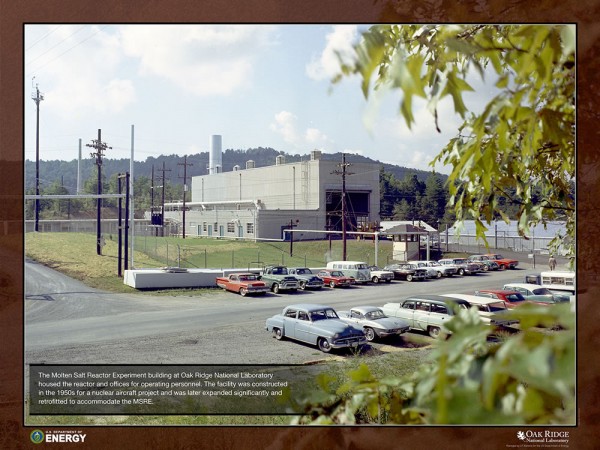
The Molten Salt Reactor Experiment building at Oak Ridge National Laboratory housed the reactor and offices for operating personnel. The facility was constructed in the 1950s for a nuclear aircraft project and was later expanded significantly and retrofitted to accommodate the MSRE. (Photo courtesy U.S. Department of Energy/Oak Ridge National Laboratory)
Note: This story was updated at 8:30 p.m.
Former director Alvin Weinberg once called it the greatest technical achievement at Oak Ridge National Laboratory. It was inspired by the campaign to build a nuclear-powered aircraft in the 1950s, and it was the first reactor to ever operate using uranium-233.
Now parts of the Molten Salt Reactor Experiment that are too radioactively “hot†for humans could be entombed in concrete.
For now, the idea is only under study, and there is no guarantee that any part of the Molten Salt Reactor Experiment, a nuclear historic landmark that has been dormant for decades, will be entombed.
But it’s one of the proposals being evaluated by the U.S. Department of Energy’s Oak Ridge Office of Environmental Management. The goal is to finish the evaluation by the end of the year.
Jay Mullis, manager of the Oak Ridge Office of Environmental Management, presented the proposal to the Oak Ridge City Council and Site Specific Advisory Board in two separate meetings earlier this month. The entombment proposal is one of five items being evaluated as part of a 45-day review started by DOE’s Environmental Management, or EM, program in June.
Most of the fuel at the Molten Salt Reactor Experiment, a unique reactor that operated for four years from June 1965 to December 1969, was removed about 10 years ago, Mullis said. That included uranium, plutonium, and some uranium-233.
But some residual fuel and fission products remain, including cesium and strontium.
Tanks still at the Molten Salt Reactor Experiment—two fuel salt drain tanks and one flush tank—are highly radioactive, Mullis said. Workers cannot be put in the underground vault that contains the tanks.
The Oak Ridge Office of Environmental Management said the dose rates in the sensitive area at the Molten Salt Reactor Experiment, or MSRE, are about 1,000 rem per hour. There is a question about how the salts would be removed.
“It’s a very hazardous operation for us,†Mullis told the Oak Ridge Site Specific Advisory Board on Wednesday, November 8, one night after he met with the Oak Ridge City Council. The fuel drain tanks stored the molten salt fuel when the reactor was not operating.
REM (Roentgen equivalent man) is one of two standard units used to measure the dose equivalent, or effective dose. It combines the amount of energy from any type of ionizing radiation that is deposited in human tissue along with the medical effects of the type of radiation.
To put the 1,000 rem per hour at the MSRE into context, Americans receive, on average, a radiation dose of about 0.62 rem (620 millirem) each year, according to the U.S. Nuclear Regulatory Commission. Roughly half of that is from natural background radiation, and the other half comes from man-made radiation sources.
At ORNL, the underground vault at the Molten Salt Reactor Experiment is about 18 feet by 21 feet and roughly 38 feet deep. The three tanks inside of it—the two fuel salt drain tanks and one flush tank—are 50 inches wide and eight feet tall.
It’s not clear yet how much entombment might cost. But Mullis said reactors have been entombed elsewhere, including at the Hanford site in Washington state.
The entombment proposal would evaluate the facility’s chemistry. There are not currently any criticality concerns, Mullis said.

Captions: Top—Hundreds of ORNL employees—including the scientists, maintenance workers, and others in these photos in the MSRE control room—played a role in the success of the MSRE during its four-year run. Bottom left—ORNL Director Alvin Weinberg took the controls on June 1, 1965, when the MSRE first went critical, using U-235 as fuel. Weinberg later called the MSRE the lab’s greatest technical achievement. Bottom right—Atomic Energy Commission Chairman Glenn Seaborg, shown pointing, was at the controls on October 2, 1968, when MSRE started its successful operation using U-233 as fuel. The MSRE was the first reactor ever to operate on U-233. (Photo courtesy U.S. Department of Energy/Oak Ridge National Laboratory)
The Oak Ridge Office of Environmental Management has estimated the cost of removing the salt from the Molten Salt Reactor Experiment at ORNL and disposing of it at the Waste Isolation Pilot Plant in New Mexico at between $150 million to $200 million.
“While we expect entombment to cost less, we are still conducting studies to determine if it is a technically feasible approach,†said Ben Williams, spokesperson for the Oak Ridge Office of Environmental Management, or OREM.
In the meantime, several million dollars is being spent each year on surveillance and maintenance at the Molten Salt Reactor Experiment and liquid and gaseous waste operations at ORNL, including at what are known as “hot cells,†and costs are expected to increase. Mullis said federal officials have asked for $12 million for those surveillance and maintenance operations in fiscal year 2019.
Mullis said the Molten Salt Reactor Experiment, which had a control room and reactor room, is degrading.
ORNL has reported that the MSRE was the “brainchild†of Weinberg, who was lab director from 1955 to 1973.
Construction began in 1962. The Molten Salt Reactor Experiment went critical on June 1, 1965, with Weinberg at the controls. It started its successful operation using uranium-233 as fuel on October 2, 1968. The MSRE also experimented with plutonium in the fuel salt. It logged more than 13,000 hours at full power during its brief four-year run.
Fully loaded, the MSRE used 11,260 pounds of a fuel salt mixture comprised of lithium, beryllium, zirconium, and uranium fluoride. The fuel salt had a melting point of 840 degrees Fahrenheit.
The coolant salt contained 15,300 pounds of lithium and beryllium fluorides.
The MSRE was designated as a nuclear historic landmark in 1994, according to ORNL. The facility itself was built in the 1950s for a nuclear aircraft project and later expanded significantly and retrofitted to accommodate the MSRE.
A 2015 article celebrating the 50th anniversary of the MSRE’s startup said the fuel-laden salt flowed from the reactor’s graphite-moderated core to a heat exchanger that transferred heat to another molten fluoride salt system, which carried the heat to an air-cooled radiator. The reactor core contained 69 cubic feet of graphite formed into 513 graphite core blocks. Passages between the blocks, called fuel channels, held molten salt fuel when the reactor was operating.
“Molten salt technology enables the development of high-temperature, low-pressure, passively safe reactors,†ORNL said. “While the alkali halide salts can be corrosive, ORNL’s development of molten salt-compatible nickel-based alloys in the 1950s to 1970s largely addressed the corrosion issues.â€
The potential for molten salt reactors to work as “breeder reactors†attracted early proponents, the lab said.
“Worries about the supply of uranium at the time appeared to disqualify nuclear as a large-scale energy source,†ORNL said in the 2015 article. “A molten-salt breeder reactor could make fuel as it operated, and the circulating fuel eliminated the need for solid-fuel changeouts and fuel- and control-rod mechanisms.
“The concept also had the allure of intrinsic safety. Molten salts expand as they heat up. The expansion causes some of the fuel to leave the core, shutting down the reactor, so operator response is not required to turn the reactor off.â€

The main control panel displayed information that the MSRE operator might need immediately, such as the temperature of the molten salt. If that temperature dropped below 840 degrees F, the salt would begin to freeze. Computers and data handling equipment, located in another room, provided current information and analysis of variables within the reactor system and of potential abnormal conditions. (Photo courtesy U.S. Department of Energy/Oak Ridge National Laboratory)
Weinberg was a staunch proponent of liquid-fuel breeder reactors, ORNL said, and the MSRE was his crowning glory.
“Here we had a high-temperature fluid-fuel reactor that operated reliably and, even in the primitive embodiment represented by MSRE, had remarkably low fuel costs,” Weinberg wrote in “The First Nuclear Era.â€
Some problems arose, such as surface cracking caused by fission products in a nickel-based alloy that ORNL helped develop. But they were manageable and for the most part eventually solved, ORNL said.
However, the MSRE had competition, according to ORNL. The Atomic Energy Commission, a predecessor to DOE, was committed to sodium-cooled, “fast breeder” designs while light-water, solid-fuel reactors eventually were adopted by the nuclear power industry. The MSRE lost funding and the entire program was shut down in 1973.
The reactor has been dormant ever since.
Still, there continues to be interest in molten salt reactors. ORNL had the third annual Molten Salt Reactor Workshop in October. It allowed leaders involved with advanced reactors—including scientists from national laboratories, the Nuclear Regulatory Commission, reactor design firms, and universities—to discuss current efforts in molten salt reactor work and pursue potential collaborations in the development of the technology for commercialization, ORNL said. More than 200 attendees heard presentations on topics from molten salt chemistry to MSR fuel modeling techniques.
Last year, the lab said interest in molten salt reactors is being driven by the ability to provide less expensive and more efficient operations in comparison to the current fleet of nuclear reactors. Most reactors used today will close between 2030 and 2050 unless licenses are extended, and that energy will have to be replaced by utilities worldwide, ORNL said.
Earlier in 2016, the lab announced that researchers at ORNL would support two new DOE-funded projects to explore, develop, and demonstrate advanced nuclear reactor technologies. One project, led by Southern Company Services, focuses on molten chloride fast reactors, and the other, led by X-energy, focuses on fuel manufacturing for a pebble bed high-temperature gas-cooled reactor.
In September 2016, ORNL said researchers were operating a test loop to see how fluoride salts would perform in transferring heat from the core of a fluoride salt-cooled high-temperature reactor. It’s the first high-temperature fluoride salt pumped test loop facility in the United States since the 1970s.
Under the 45-day review outlined by Mullis this month, EM sites reviewed their programs and determined where timely decisions could help lower costs, save time, or reduce administrative burdens. Besides the MSRE entombment, other items in Oak Ridge included in the 45-day review are in-cell macro encapsulation at the Environmental Management Waste Management Facility on Bear Creek Road west of the Y-12 National Security Complex; setting up a path to dispose of elemental mercury that is not radiologically contaminated, including at Y-12; accelerating the collection of medical isotopes from uranium-233 materials at ORNL; and using remote-handled “waste overpacks†to allow transuranic waste that must be handled remotely to be disposed of at the Waste Isolation Pilot Plant in New Mexico.
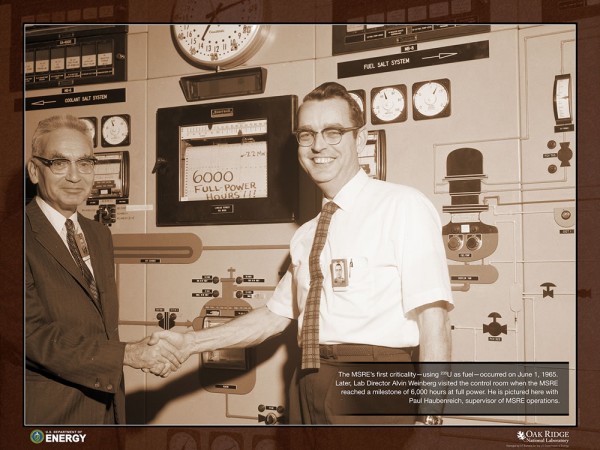
The MSRE’s first criticality, using U-235 as fuel, occurred on June 1, 1965. Later, Lab Director Alvin Weinberg visited the control room when the MSRE reached a milestone of 6,000 hours at full power. He is pictured here with Paul Haubenreich, supervisor of MSRE operations. (Photo courtesy U.S. Department of Energy/Oak Ridge National Laboratory)
See ORNL posters commemorating the 50th anniversary of the start of the MSRE here. See an ORNL story on the 50th anniversary from 2015 here.
See another story on the MSRE here.
See a story on the advanced nuclear reactor workshop in 2016 here.
See the 2016 story on ORNL’s support of advanced nuclear reactor projects here.
See this video of ORNL researcher Kevin Robb giving an up-close look at the lab’s liquid salt test loop.
See Mullis’ 45-day review presentation here.
Learn more about rem here. Learn more about measuring radiation here. Learn more about doses in our daily lives here.
More information will be added as it becomes available.
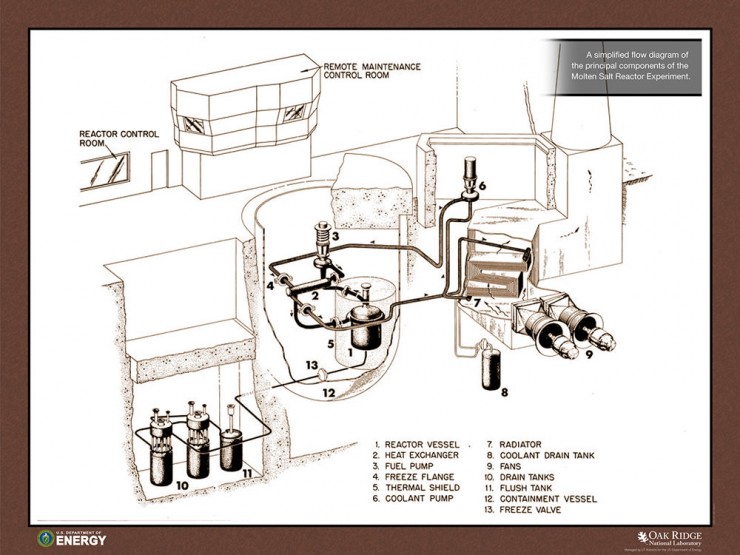
A simplified flow diagram of the principal components of the Molten Salt Reactor Experiment. (Image courtesy U.S. Department of Energy/Oak Ridge National Laboratory)
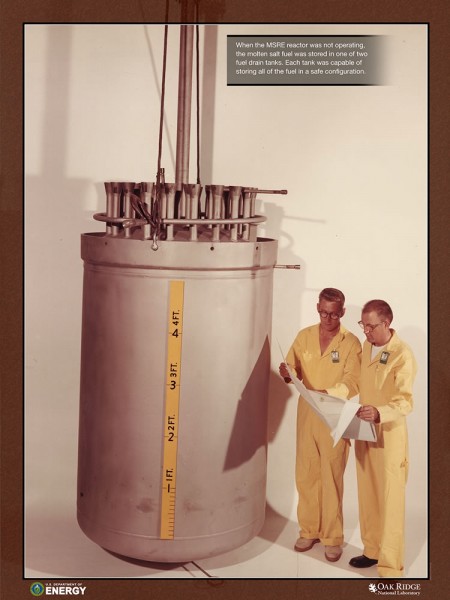
When the MSRE reactor was not operating, the molten salt fuel was stored in one of two fuel drain tanks. Each tank was capable of storing all of the fuel in a safe configuration. (Photo courtesy U.S. Department of Energy/Oak Ridge National Laboratory)

ORNL Director Alvin Weinberg’s interest in molten salt reactors led to a 1959 lab proposal for funding from the U.S. Atomic Energy Commission to develop the MSRE. Construction began in 1962. The MSRE reactor core, shown during assembly, contained 69 cubic feet of graphite formed into 513 graphite core blocks. Passages between the blocks, called fuel channels, held molten salt fuel when the reactor was in operation. (Photo courtesy U.S. Department of Energy/Oak Ridge National Laboratory)

The completed reactor vessel was inspected before installation in its containment cell. Holes near the vessel’s top distributed incoming salt evenly around the vessel in a downward flow. Fully loaded, the MSRE used 11,260 pounds of a fuel salt mixture comprising lithium, beryllium, zirconium, and uranium fluoride. The coolant salt contained 15,300 pounds of lithium and beryllium fluorides. (Photo courtesy U.S. Department of Energy/Oak Ridge National Laboratory)
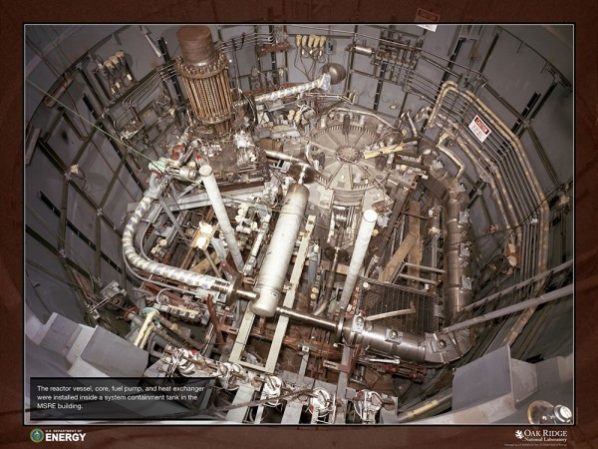
The reactor vessel, core, fuel pump, and heat exchanger were installed inside a system containment tank in the MSRE building. (Photo courtesy U.S. Department of Energy/Oak Ridge National Laboratory)
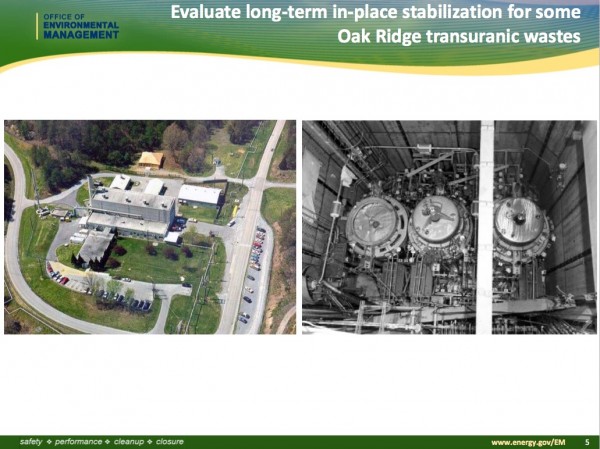
A slide from a November 2017 presentation by Jay Mullis, manager of the U.S. Department of Energy’s Oak Ridge Office of Environmental Management. Mullis discussed a proposal to entomb the Molten Salt Reactor Experiment at Oak Ridge National Laboratory. (Slide courtesy U.S. Department of Energy/Oak Ridge Office of Environmental Management)
Do you appreciate this story or our work in general? If so, please consider a monthly subscription to Oak Ridge Today. See our Subscribe page here. Thank you for reading Oak Ridge Today.
Copyright 2017 Oak Ridge Today. All rights reserved. This material may not be published, broadcast, rewritten, or redistributed.




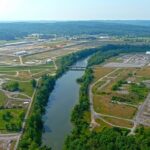
Leave a Reply